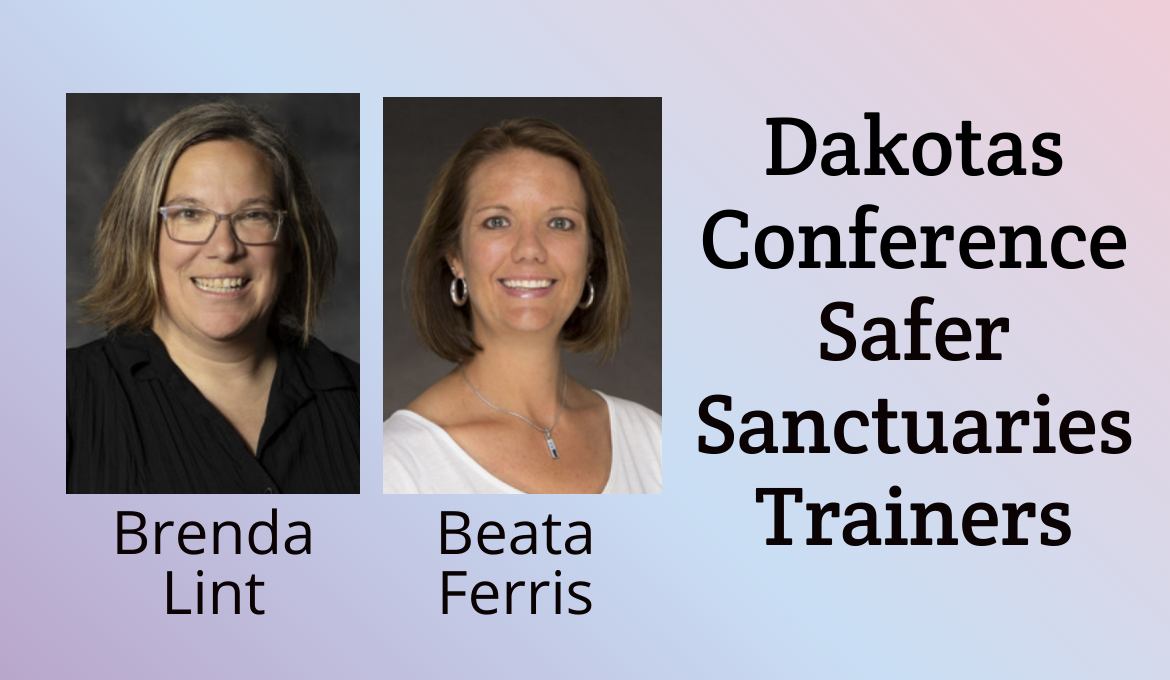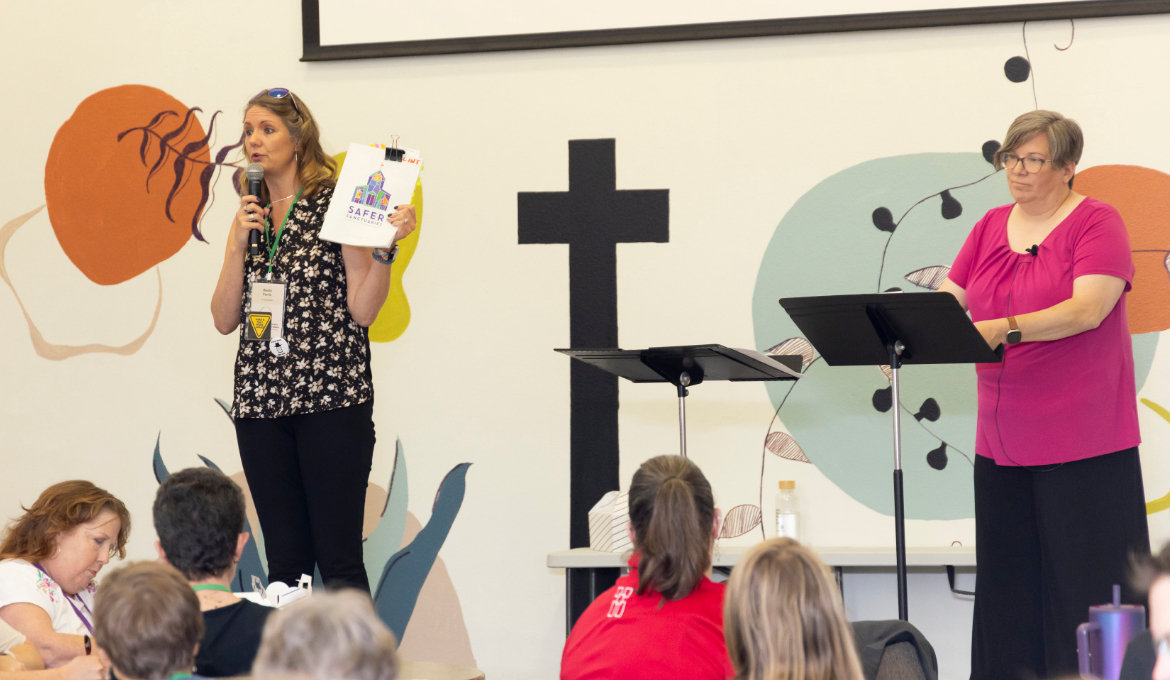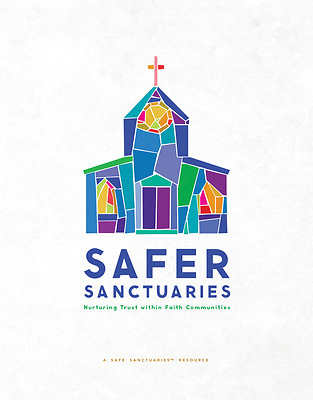
A ministry of safety, care, and trust - Safer Sanctuaries
"We try to emphasize coming at it from a ministry point of view—not a fear point of view—and the ministry point of view is 'I do everything to protect all the children and all the adults,'" explained Brenda Lint about Safer Sanctuaries practices.
According to the United Methodist Discipleship Ministries website, "' Safer Sanctuaries: Nurturing Trust within Faith Communities' is a new and comprehensive resource that continues the tradition of Safe Sanctuaries ministry by building on the trusted policies and procedures that have guided churches over a quarter of a century. The implementation of Safer Sanctuaries enables faith communities to be empowered and flourish as they develop and implement policies and procedures that make everyone safer."

Brenda Lint and Beata Ferris serve as the Safer Sanctuaries trainers for the Dakotas Conference.
Brenda Lint, a layperson from Spearfish UMC and former co-director of Wesley Acres Camp, along with Beata Ferris, discipleship coordinator from Pierre First UMC, attended a train-the-trainer event for Safer Sanctuaries last year. Now, they are sharing their passion for this ministry to equip congregations across the Dakotas to be intentional about implementing policies and practices that protect children, youth, and vulnerable adults.
"I went to the training wearing my Pierre First UMC discipleship coordinator hat because I know that our safer sanctuaries policy needs to be updated and better implemented," explained Beata. "But once I got there, I realized the implications for us as an annual conference and how important it is for all local churches to have support in updating, reviewing, and continually implementing their safer sanctuary policies and best practices."
"The highlight I came to understand through my training is that there is no set standard that's the same for every church," explained Brenda. "You can't have the same policy or expectations because no two churches do the same ministry or have the same people going in and out or have the same facility. You have to consider all that when you're creating your policy."
At a recent lunch-n-learn workshop at annual conference, the two women shared some of their learnings and offered tips and tools for churches to get started.
Where do I even begin? What's my first step?
"I think your first step is to sit down with a leadership team or, at minimum, the pastor, and decide, 'Who should be responsible for this in our church?'" explained Brenda. This conversation should lead to forming a team that can determine what policies and practices the church is currently engaging in, areas of vulnerability or concern, and what specific things need to be updated or included.
"At a minimum, you need to realize the supervision requirements for kids, youth, and vulnerable adults," emphasized Brenda. Safer Sanctuaries guidelines require at least two non-related adults (including at least one screened adult) to always be present in activities with children or youth.
In an era when getting people to serve in children's or youth ministries can be challenging, there is sometimes pushback regarding this requirement.
"Many people are concerned they don't have enough volunteers," described Brenda. "But I like to point out that if you need two people for a Sunday school class, for example, you don't need two teachers. You need one person who is teaching or leading and one other adult. That meets the two unrelated adults requirement."
As she explained, the second adult is there to be kind and make sure everything goes well. It's also an opportunity to involve someone who may be hesitant or lack the gifts to teach or lead.
A related challenge is using youth as leaders of children's ministry and the need for two adults who are 18 or older.
"Some churches are using youth to supplement their volunteer team, which is great for empowering youth," said Brenda. "However, as the church, we still need to see those youth as youth. We also need to continue our guidelines and policies in keeping the youth safe."

Beata Ferris and Brenda Lint lead a Safer Sanctuaries Lunch-n-Learn at the 2024 Annual Conference in Bismarck, ND.
A common challenge and pushback she hears from smaller congregations is, "We all know each other." At a recent workshop, one attendee talked about their church, which only had six kids, and they were all cousins—something that is not uncommon in our Dakotas rural congregations.
"In those cases, I remind them that, when something bad happens, the first thing that comes out is how shocked friends and family are because they never would have guessed—they didn't know this side of this person," Brenda shared.
"Unfortunately, the history that we, as a church, have had of just assuming that all people are good is no longer adequate."
As she explained, we shouldn't neglect good policies and practices under the excuse of "we know them and trust them." Because we know and trust people, we should be able to know and trust that they would be willing to abide by these policies because it should be important to them as well.
Background checks are also critical tools for creating safe ministry environments. For churches who don't want to set up their own account with a company that does background checks for volunteers, the Dakotas-Minnesota Camping office can resource churches by running background checks for those who are volunteering in these ministries with children, youth, or vulnerable adults. The basic background check is $9.75.
While Brenda recommends that everyone who regularly volunteers have a background check, churches can check other options, such as the national sex offender registry, to ensure volunteers for one-time events (e.g., VBS, Trunk-or-Treat, etc.) are cleared and children are protected.
Is your space set up to be safe? Are your systems secure?
After addressing supervision, the physical space of the ministry and systems like check-in and check-out are other vital areas to assess when developing a safer sanctuaries policy. One facet of this area is being clear on the parent's role and the church's role in supervising kids.
"During the worship service, the parent is in charge of the supervision," explained Brenda. "Even with that said, is your church set up in a way that, if a child leaves worship to go to the bathroom, they are vulnerable at that point? Now it rolls back to the church to say, 'What are we doing so they are safe in that moment?'"
Some churches have used strategically located greeters to prevent people from wandering into the children's area if they are not serving in the ministry.
Trustees can be important partners in this effort, as a church's insurance company often expects them to address matters of care within the facility.
What about safety in online spaces?
After a Resolution was passed at the 1996 General Conference regarding the need for policies to protect children and youth in our churches, many congregations did the work to create a policy but haven't necessarily bothered to keep it up to date.
However, the world has changed since 1996—most markedly in the digital sphere.
"Many of our local churches don't have a social media or an electronic communication policy as a part of their safer sanctuary," pointed out Beata. "We need to consider what will be allowed regarding social media best practices and electronic communication with children, youth, and vulnerable adults."
Churches should consider including policies and practices that acknowledge this in their Safer Sanctuaries work. Some suggestions include:
- Do not post pictures of kids on your church's social media or website without parental permission.
- Only include wide-shot pictures of kids' events, so children are not recognizable.
- Never have a child's picture and name together, including in online bulletins (e.g., acolytes)
- Be cautious of putting people's birthdates with first and last names on the online bulletin.
- For events like Confirmation or the Christmas program, have parents (and teens) sign off that they are okay with being online and/or having their name used.
- For children's message time, ensure the camera angle doesn't show kids' faces and the leader doesn't say names.

The updated Safer Sanctuaries manual provides useful tools for congregations seeking to develop and implement policies and practices to care for children, youth, and vulnerable adults.
Brenda and Beata strongly recommend getting the book "Safer Sanctuaries – Nurturing Trust within Faith Communities" as it can help churches identify other areas of potential concern and walk them through the importance of addressing them.
Beyond their work with children and youth, churches must remember that vulnerable adults also need care.
"I don't think a lot of churches recognize that when you have a visitation ministry that is going into other people's homes, you need to have a plan for that," explained Beata. "As our congregations age, those are ministries that we should have, and we also need to do it in a way that protects our vulnerable adults and our volunteers."
Churches can contact either Brenda or Beata to provide training in person or via Zoom or simply to act as resources or connectors to tools and information. They will offer a conference-wide training webinar at two different times this fall: Saturday, November 2, from 10 a.m. to 12:30 p.m. and Tuesday, November 12, from 6 p.m. to 8:30 p.m. (Central Times). Check out the Conference website for more information and to register.
"The thing that I'm realizing is that our church buildings have changed because people are using their buildings differently than they have been," emphasized Beata. "Our ministries have changed because the world has changed, and so our policies and practices to keep people safe in those buildings and with those new ministries need to change."
"I know it can feel annoying to have stipulations in place. I know it can become harder than it was in the past," Brenda added. "But you just have to move forward. It's just necessary to acknowledge that these things have happened."
"When you put safeguards in place, it's harder maybe, in your eyes, to do your ministry. But it's also harder for the negative impact to happen in your ministry. So you just have to acknowledge that and move forward rather than fight against it."